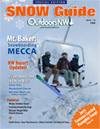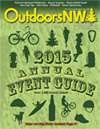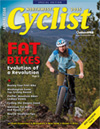Winter birding takes off
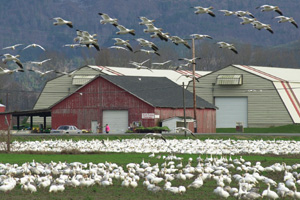
Escapes: November/December 2010
By Sharon Wootton and Maggie Savage
Photos by Sharon Wootton
Never underestimate the power of winter birding.
We’ve found it well worth the chill, layers of clothing and hot drinks to enjoy flocks of migratory birds, the hoots of owls and the thrill of discovering an uncommon avian visitor. Whether you want to see raptors in wide open spaces in the high desert of Oregon or bald eagles along the Upper Skagit River in Washington, birdwatching is an accessible outing that can be enjoyed with just binoculars.
Here are four destinations that offer a variety of birding opportunities.
Raptor- and owl-watchers delight
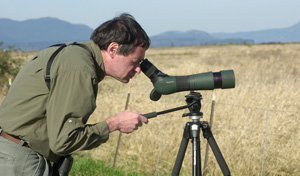
While not necessary, a scope brings the birds to you. It’s stronger than binoculars but a little harder to get used to. Photo by Sharon Wootton
When the Mahleur National Wildlife Refuge was established in 1908, it was one of six refuges west of the Mississippi. Its 187,000 acres are 30 miles south of Burns in the southeast corner of Oregon. In winter, it’s one of the best places to see raptors.
“We get a huge influx of rough-legged hawks coming down from the north. It’s a fabulous time if you’re into raptors,” says refuge archeologist Carla Burnside.
Golden eagles are year-round residents, as are California quail that skitter along in coveys of 20 to 40 birds.
“It’s one of the densest winter populations in the country,” Burnside says.
The refuge folks will be glad to send you to the best birding locations. You’re likely to see the resident population of great horned owls near the headquarters. They start breeding calls on January evenings.
While there can be a little snow on the ground, the refuge has more sunny days in winter than cloudy ones.
A gathering of eagles
The Upper Skagit River near Rockport, Wash., is the best and most accessible bald eagle-spotting area in the Northwest. Hundreds of eagles have been counted in a stretch of the Skagit, feasting on carcasses of salmon that died after spawning. The highest eagle count is usually in the last two weeks of December.
Volunteers in the Skagit Eagle Watchers program are at several locations on the east side of the Rockport Bridge along S.R. 20. Birders can see 50 to 200 or more eagles and learn about them from the volunteers, who will have birding scopes to share.
An interpretive center, open on winter weekends, offers walks and talks.
Snow geese by the thousands
It’s a spectacular show when more than 20,000 snow geese and about 300 tundra swans descend on the Skagit Valley Wildlife Area. The convenient Washington Department of Fish and Wildlife viewing area is at the Fir Island Farms/Hayton Snow Goose Reserve, an area planted in winter wheat to attract the geese.
The geese and wildlife managers prefer that you use your vehicle as a blind so that you won’t spook them into flight, which wastes valuable calories for their long flight back north next year.
For the more adventuresome, hike the two-mile trail on top of a dike in the Wiley Slough area of the Skagit Wildlife Area.
Birding east of the Cascades
North-central Washington is an accessible location to see species not often spotted in that location. Many fly down from the north or from higher elevations. Most casual birders are surprised to find this variety on the east side of the state.
During the winter many species congregate more than during other seasons. You might find flocks of 50 to 300 snow buntings, 50 to 200 common redpolls, and hundreds of Bohemian waxwings.
Like owls? Birders have found six owl species, as well as goshawks, golden eagles, merlins and prairie falcons. Keep an eye on the ground for grouse, chukars and partridge.
And if you’re lucky, you’ll catch a mild, sunny day.
Birding Festivals/Resources
Birding festivals are an excellent way to hear expert birders and take guided walks. The three-day Winter Wings Festival (www.winterwingsfest.org) is held in Klamath Falls, Ore., a birding hotspot with six refuges. It is home to the largest concentration of wintering bald eagles on the U.S. mainland.
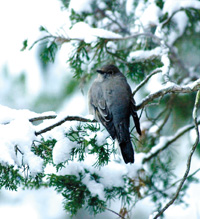
One of the joys of birding is to see the unexpected, such as this berry-eating Townsend’s Solitaire. Photo by Sharon Wootton
The sixth annual Port Susan Goose and Birding Festival (www.snowgoosefest.org) is held in February at the mouth of the Stillaguamish River, east of Camano Island.
The Upper Skagit River Bald Eagle Festival was cancelled last winter due to a lack of funding but there are hopes for it coming back in late January or early February.
Take a walk with your local Audubon Society. The guides are familiar with the birds and best birding locations in your area. For a list of chapters, go to www.audubon.org/chapters. Or join a local chapter for the annual Christmas Bird Count.
For information on the Malheur National Wildlife Refuge, call (541) 493-2612 or go to www.fws.gov/Malheur. Pick up a map and check out the refuge’s museum.
To find snow geese, call the Mount Vernon Chamber, (360) 428-8547, or stop by their office and pick up a map.
For information on the Skagit eagles, see www.skagiteagle.org.
To become a volunteer Eagle Watcher, call Greta at (360) 854-2630.
Writers Sharon Wootton and Maggie Savage are authors of “Off the Beaten Path: Washington.” They live in the San Juan Islands.

